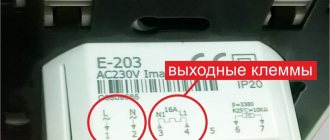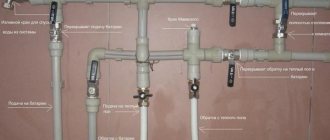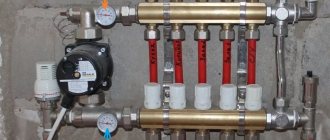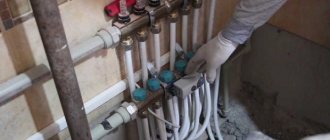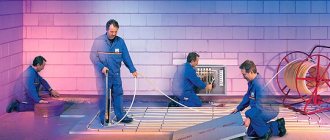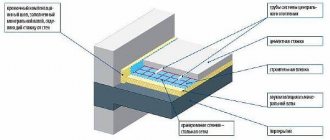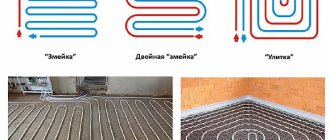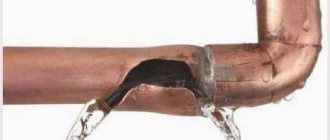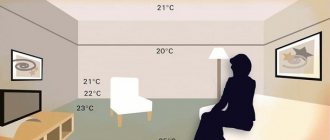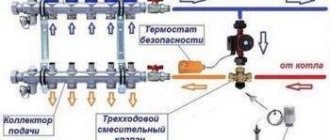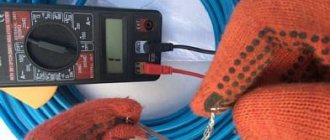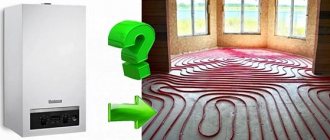In a forced circulation heating system, the heart is the circulation pump. The presence of heating and its quality depend on its stable operation. The same applies to closed hot water supply systems with a constant flow of water in the pipes between the boiler and the storage tank. During operation, the question inevitably arises of how to service and repair the circulation pump so that it continues to operate stably and without failure.
For normal operation of the pump, the following measures must be taken:
- Correct operation taking into account all the rules established by the pumping equipment manufacturer.
- Pump prevention and maintenance.
- Diagnostics and repair in case of pump failure.
The more accurately the operating rules are followed and the more regularly the pump is serviced, the less often you will have to think about repairing or replacing it.
Correct operation
A number of simple requirements apply to any circulation pump:
- Do not allow the pump to idle in the absence of water. Applies to both wet and dry pump types.
- The pump should not be allowed to operate with the water flow stopped, for example, if the valve before or after the pump is closed.
- The optimal operating mode should be determined taking into account the maximum and minimum throughput of the equipment.
- It is important to comply with the manufacturer’s requirements for the nominal water pressure in the system.
- The coolant temperature should not exceed 65°C. Therefore, the circulation pump is installed on the return line in front of the boiler, where the cooled water flows. When a given threshold is exceeded, the process of deposition of hardness salts on the internal surfaces of the pump accelerates many times over.
- Long periods of downtime should not be allowed. About once every month or two, it is advisable to turn on the pump for 15 minutes. If this is not done, then the risk of shaft jamming increases during the oxidation process.
- It is unacceptable to use a circulation pump to pump dirty water containing dense particles in suspension. A coarse filter must be installed, or the purity of the water or coolant is monitored in other ways.
In operating mode, the pump must have a uniform sound of the operating drive and a constant output pressure value, which is monitored by an installed pressure gauge. If handled well, even the simplest circulation pump can operate for up to 5 years until its main elements wear out.
Additional recommendations
As complexity increases, the cost increases, but the overall reliability of the equipment decreases. As an example, control valves on a manifold comb can be used. Designs with mechanical drives cost little.
Their characteristics have been developed over many years of practice, so breakdowns rarely occur. Servo drives are more expensive. The corresponding systems contain electronic units, miniature electric motors, wire connections, and sensors. There are more components that can fail.
The components for removing air from the system should be selected taking into account the design features. Simple Mayevsky cranes are capable of performing their functions flawlessly for a long time. They do not need to be adjusted during operation. Automatic devices are more complex and more expensive. They can be damaged by dirt, so they need protection from mechanical impurities.
Design
Almost all circulation pumps are centrifugal type. They have an impeller mounted on the motor shaft and placed in a special “shell” chamber. The entrance to the shell is located in the center, while the exit is the outer edge of the shell with a channel extending around the circumference in the direction of movement of the impeller. The engine spins the impeller, and water, under the influence of centripetal force, rushes from the center to the edges of the sink from inlet to outlet.
Pump structural elements:
- pump part, sink and impeller mounted on the shaft;
- electric motor;
- electronic control unit.
The most susceptible to wear is the moving part of the pump - the motor shaft and impeller, as well as the bearings on which they are mounted.
Prevention and Maintenance
Long service life and trouble-free operation are possible only if proper operating conditions and regular maintenance of the pump are observed. Maintenance means periodic inspection and cleaning of the pump. Inspection for abnormalities in operation should be carried out at least once a quarter, that is, twice during the heating season. It is advisable to perform cleaning every two to three years, depending on the quality of the water and the conditions in which the pump operates.
During the entire period of operation, it is advisable to periodically check the operation of the pump:
- Connections are checked for leaks. If identified, gaskets and seals (tow, FUM tape, etc.) are replaced.
- The presence and condition of grounding is visually checked.
- The sound of a running engine should not be accompanied by clangs, knocks, or extraneous sounds.
- The engine should not vibrate much.
- The pressure in the line is checked and its compliance with the nominal one.
- The housing must be clean and dry. If this is not the case, then you should carry out external cleaning, check the electronic unit for flooding and eliminate the reason why the pump is wet.
Approximately every two to three years, it is advisable to clean the pump, including all its elements. This only applies to models that can be disassembled. There are pumps with a pressed or solid, welded casing that does not require repair or disassembly. Such units fail and are then replaced with a new assembly. It is advisable to entrust this work to a service center. However, if you have the skills and tools, you can do everything yourself
- hex wrench;
- slotted screwdriver (flat) 4 and 8 mm;
- Phillips screwdriver.
Before disassembling the pump, drain the water from the system or drain a separate area in which the pump is involved, dismantle it and then begin disassembly.
- Using a hex wrench or Phillips screwdriver, unscrew 4-6 bolts around the perimeter of the engine housing at the junction with the shell of the pump part.
- Remove the shell, leaving the impeller on the rotor shaft along with the engine.
- Locate four drainage holes around the perimeter. Using a narrow slotted screwdriver, pry the jacket of the engine compartment under the impeller little by little around the perimeter. As a result, the shaft with the rotor and impeller will come out of the grooves and stator shell. You can help yourself by unscrewing the protective plug on the outside of the pump, inserting a screwdriver into the slot at the end of the shaft and lightly knocking the shaft out of the support bearing.
Water system malfunctions
Types of faults
The reasons for the absence or insufficient heating of the room with a water-heated floor are most often:
- pipeline damage;
- uneven heating;
- electrical equipment malfunctions.
It is also common to encounter errors when performing thermal insulation work, incorrect calculations and selection of characteristics of the boiler and other main elements of the system.
Methods for laying pipes for a water floor
Troubleshooting
Tube damage
The cause of breakthrough and leakage of water heated floors is often a decrease in pressure in the coolant supply tubes. Their tightness is broken, the volume of water involved in heating decreases, and the water that leaks out violates the integrity of the screed and can leak to the lower floor, flooding the neighbors.
To determine the location of a possible leak, a visual inspection of the finished floor covering is performed. Traces of wet spots can be found at the junctions of its elements or directly on the surface. If you cannot detect the presence of moisture during inspection and palpation of the surface, you should use a special device - a thermal imager.
After identifying the location of the damaged part of the pipe, it is necessary to carry out local repairs by partially dismantling the coating area and dismantling the screed. Before replacing the pipe, you need to drain the water from the circuit, and before restarting after repair, remove air from the system.
Before pouring concrete screed onto the repaired section of the circuit, you should ensure that there are no leaks. It is recommended to protect the coupling from the acidic environment of the concrete solution by wrapping it with a piece of foamed polyethylene.
Uneven heating
One of the reasons why a water floor does not heat is the uneven distribution of coolant in the pipes. This reason is most often associated with different lengths of the circuits - with the same intensity of coolant supply in longer systems, the water cools faster.
The problem is solved by regulating the supply of coolant to each of the circuits on the manifold and adjusting the levels of electric drives on the supply valves.
Diagram of a water heating floor collector
It will take some time to feel the results of the changes made to the system. The heating time of a water heated floor depends on the following nuances:
- the number of layers and material of the floor covering;
- water temperature;
- coolant supply speed;
- heater power;
- weather conditions.
The adjustment process can be significantly simplified and facilitated by the use of simple and inexpensive automation equipment - a commutator servo drive and a temperature sensor. An external analyzer (thermostat) is capable of automatically monitoring and adjusting the supply of heated coolant to the circuit.
Troubleshooting
Based on how the pump operates, sound, vibration or changes in pressure, outlet pressure, it is necessary to accurately determine the malfunction and eliminate the cause.
| Symptom of malfunction | Probable Cause | Repair |
| The pump makes sounds after switching on, but the shaft does not rotate | Shaft oxidation due to prolonged inactivity | Unscrew the protective cap from the end of the shaft on the motor housing and manually turn the motor shaft using a slotted screwdriver. |
| Blocking by a foreign object | Disassemble the pump block with the impeller and clean it, check the condition of the coarse filter installed in front of the pump | |
| Power problems | Check the voltage rating in the network and correct the problem if necessary. | |
| After applying voltage, the pump does not start and does not make any sounds. | No actual voltage on power line |
Repair
It is best to take a broken circulation pump to a specialized service center, especially if it is still under warranty. Most of the models currently on the market, unfortunately, are non-separable or partially disassembled, so if problems arise with its internal spare parts, entire units or the pump assembly must be replaced. If the warranty period has already expired, and the design of the pump allows you to disassemble it and get to all the main components, then, if you have the appropriate skills, you can carry out the repair yourself.
Having determined the cause of the malfunction from the table above, it is enough to disassemble the pump, as indicated in the paragraph on prevention and maintenance, and replace the faulty part.
The main elements in the pump control unit are:
- 1-5 microfarad capacitor;
- terminal block for connection;
- speed controller.
Due to the small capacitance of the capacitor, you can check it using a multimeter, which has a built-in C-meter with a limit of up to 20 µF. If the readings deviate significantly from the nominal value, the capacitor should be replaced; it is important to maintain the polarity of the connection and be sure to have its voltage tolerance. For a conventional single-phase motor, capacitors with a tolerance of up to 450 V are used.
The speed controller assembly is replaced with a new one. It is enough to disconnect it from the terminals, remembering the position of each pin and connect a new one.
Popular models of circulation pumps are from the manufacturers Wilo, Ggrundfos, Dab. Not least due to their reliability. You can expect these pumps to break down within the warranty period only if the recommended operating conditions are violated. However, during the post-warranty period, Wilo often has problems with support bearings. Only replacing them helps.
Ggrundfos and Dab can “please” the impeller to become overgrown with scale for high-temperature heating systems, as well as silting of the stator cup. It is better to prevent these problems by installing a good filter and preparing the water. Otherwise, breakdowns are often justified by external problems.
Pumps are the most important part of forced circulation heating systems. Depending on their location in the heating system, they are responsible for the temperature of radiators or heated floors, forcing the coolant to circulate from the boiler through all heating circuits, thereby giving the residents of the house warmth and comfort. But then something bad happened - the pump broke. The eternal question immediately arises - what to do? Should I take it to a heating pump repair shop, try to fix it myself, or immediately buy and install a new circulation pump?
Thermal sensor malfunction
The temperature sensor should protect against excessive energy consumption (if the heated floor is electric). Its task is to turn off the heating when the temperature reaches the desired limit. Failure of this sensor will mean that the floor will constantly heat up and waste energy.
Proper installation of the temperature sensor is carried out in a corrugated tube between the heating elements. In this case, you can replace the sensor without seriously dismantling the entire coating.
Operating rules
To prevent breakdowns, follow the operating rules:
- It is prohibited to operate the house heating pump if there is no water in the system;
- do not use the unit at zero supply;
- During operation, feed limits are observed;
- to prevent oxidation during downtime, the unit must be turned on for fifteen minutes;
- the temperature of the working fluid does not exceed sixty-five degrees Celsius;
- no leaks at pipe connections;
- no heating of the unit;
- Do-it-yourself pump installation involves horizontal placement of the shaft.
If the rules are followed, the unit can last ten years.
Breakdowns and troubleshooting methods
Depending on the problem, the cause of the breakdown and its elimination are determined:
- The circulation pump does not turn on and does not make noise. The reason is a burned out winding or a broken fuse. The fuse or winding is changed;
- When the unit is turned on, a hum is heard, but the shaft does not rotate. Why does the unit hum but not work? Most likely, during prolonged inactivity, oxidation of the shaft occurred. If the device is blocked, it is disconnected from the network. The screws connecting the engine and the housing are unscrewed. The motor is removed and the shaft is turned. For low-power units, the shaft is unlocked using a screwdriver;
- The pump turns off after it is turned on without starting to work. The reason is scale between the stator and rotor. After dismantling the engine, salt deposits are removed;
- During operation, the device begins to heat up. Why does the engine get hot? There are several reasons for heating. Incorrect installation, poorly lubricated bearing, low mains voltage, system clogging. To eliminate the voltage problem, an uninterruptible power supply (UPS) is installed for the heating pump. A UPS is used for continuous power supply and protection against power surges. In the absence of electricity in the network, the UPS will ensure the operation of the unit for fifteen minutes (used as a power source). The UPS will protect the pump motor in the event of a surge, sudden drop or fluctuation in the voltage in the network. By connecting a UPS, the heating system will be protected from power surges. Mains power will be safe;
- food problem. The compliance of the actual voltage in the network with that specified in the characteristics is checked;
- the impeller is blocked. To troubleshoot the problem, you need to know how to disassemble the device. To eliminate the breakdown, the wheel is dismantled and the foreign object is removed. To prevent reoccurrence of blocking, a filter is installed at the pump inlet;
- When turned on, the pump may hum. The reason is accumulated air. To fix the problem, you need to bleed the air from the system. Automatic air vents will constantly bleed air. An air vent is needed to bleed air during operation and startup of the system;
- The unit vibrates during operation. The reason is bearing wear. The bearing needs to be replaced. The second reason is a clogged filter. The filter needs to be washed and cleaned;
- after switching on, the electric motor protection is activated. The reason is the engine electrics. It is necessary to contact a specialist;
- The water pressure is lower than specified in the technical specifications. We made a mistake while installing the device. Found in three-phase types of equipment.
Do-it-yourself heating pump repair (video)
Prevention of breakdowns
To prevent breakdowns, you need to check the serviceability of the heating pump yourself. Before the heating season begins, the unit is checked for breakdowns.
- Check for lubrication. When the pipes dry out, lubricate them.
- Check that the device is connected to the network correctly. When planning the heating system, it is necessary to place the pump in front of the boiler. This measure will reduce the formation of air jams to zero.
- The equipment is checked using a tester for correct connection to the network.
- Cleaning the filter from dirt.
- Before starting the heating, the equipment is tested. To pressurize the heating system, water or air is supplied to the system. For crimping, a hydraulic or pneumatic pump is used.
Correct and incorrect installation of the circulation pump
The influence of the crimping process on the injection mechanism
The pressure testing process ensures high-quality maintenance of the entire heating system.
In order for the entire system to operate without leaks and turn on without problems, this procedure is carried out. The procedure is carried out after disconnecting the system from the network and removing the coolant. Before the procedure, the pipes must be pressed (cleaned) of scale. Scale, deposited on the internal parts of the pipes, reduces their permeability by fifty percent, increasing the load on the supercharger. It will become difficult for the pump to pump water through the system and it will quickly fail. Circulation will be disrupted throughout the entire system. Heating will not be effective.
If the heating system is not pressurized once every five years, the centrifugal pump will not cope with its task.
How do heated floors work?
Having studied the specifics of the system’s operation and the features of its design, you can easily identify the causes of malfunctions and promptly eliminate them.
The most common types of structures are electric and water.
Electric floor
The operation of the system is ensured by heating the cable through which an electric current is passed.
The temperature of the heating element increases due to the internal resistance of the material - most electric heating household appliances, for example, electric kettles and electric stoves, operate on the same principle.
Electric floor
A single or two-core cable is used as a heating element, laid directly into the screed or under the finishing floor covering. The operation is controlled by a thermostat that automatically turns off the system when the temperature set by the user is reached.
The principle of operation of a water floor
This type of warm floor consists of a water radiator laid horizontally on top of the floor slab. The structure is protected from loads arising during operation with a concrete screed.
Water heating system
In most cases, the heating circuit consists of two tubes through which coolant circulates in a closed circle. The water heated in the boiler enters the main heating system, heats the screed to a temperature of 27-36°C and, when cooled, returns back to heat up again.
A temperature sensor is installed in the “floors”, which, when the user-set air temperature in the room is reached, sends a signal to stop the supply of hot coolant. This function is important primarily for floors that have temperature restrictions in operation.
